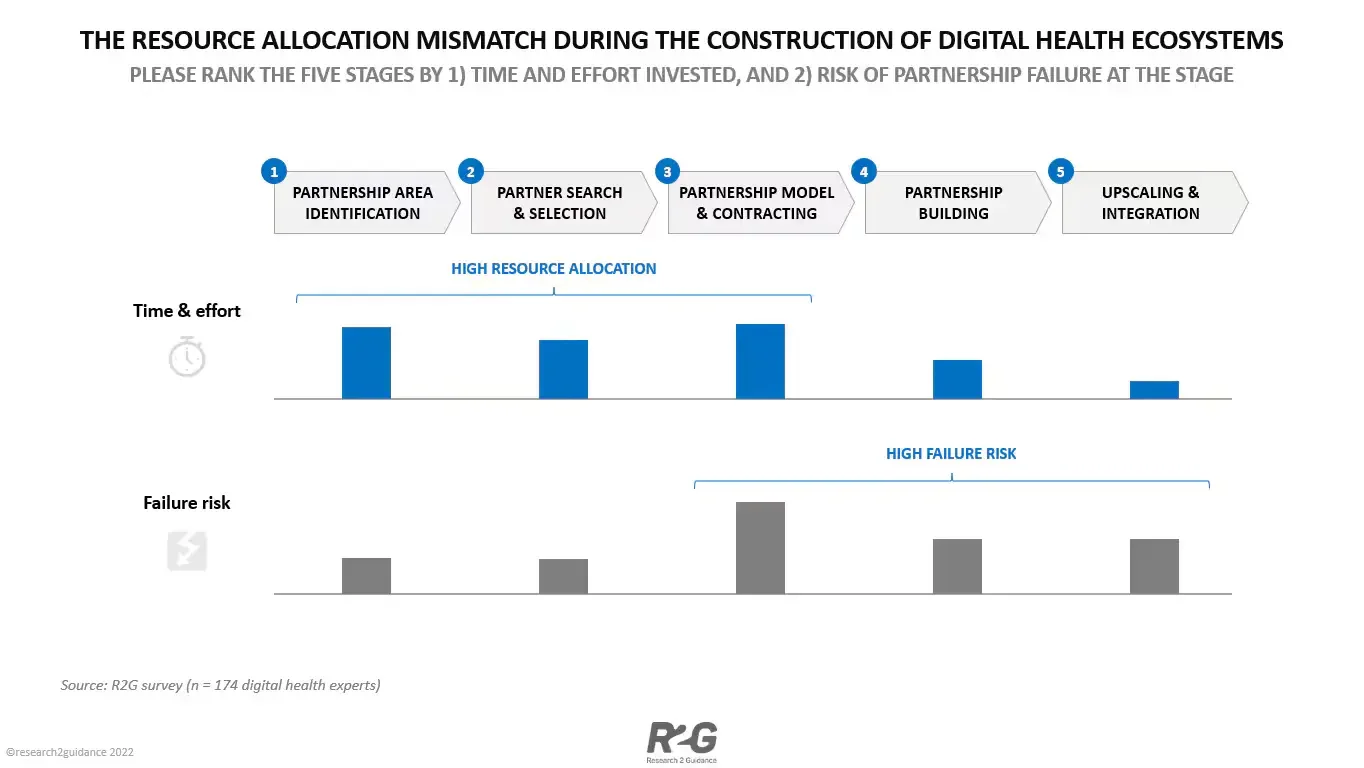
May 13, 2022
An increasing number of healthcare companies worldwide recognize the need to connect digital health solutions to serve better their patients, employees, or health plan members. A whitepaper recently published by Research2Guidance, a consulting and market research company focusing exclusively on digital health, recognizes that digital health ecosystems are in high demand with pharma, med tech companies, health insurers/payers, care providers, and regulators, all looking to connect digital health solutions.
Most of the approaches that these players are taking for building digital health ecosystems include models, such as hackathons, accelerators, incubators, company builders, investment arms, etc. seem challenged with a natural implementation of successful digital health ecosystems and hence calls for a new approach.
The process of building digital health ecosystems can be broadly broken down into 5 stages –

According to R2G research, healthcare companies spend most of their time and effort on the first two stages (i.e., market research and partner search) and less time and effort on the actual partnership setup (partnership model, contracting, piloting, and monitoring) and the integration of the digital health partner solution into their value propositions. Therefore, all activities supporting the distribution and marketing of the solution within the target user group are not yet the focus of the healthcare companies.
Bayer G4A was included as a research highlight as one of the more prominent examples of an industry partnership program that has changed over time to adapt to the industry’s increased expectations for digital ecosystems. Our approach to evolve the partnerships program to increase the impact beyond culture change and brand awareness, and to further focus efforts on the partnership setup is reaffirmed by the R2G research.
In the whitepaper, R2G also explores how to successfully build a thriving digital health ecosystem by recommending Eight Building Blocks in establishing successful partnerships. Bayer G4A as a digital health ecosystem orchestrator can leverage on these insights.

1. Value Proposition
Bayer G4A, known as digital health ecosystem orchestrators, has a strong commitment in growing its partnerships. As part of the larger Integrated Care team, Bayer G4A ensures to steer digital health partnerships and investment and externally serve as ambassadors for digital health innovation and transformation.
2. Roadmap
Defining a roadmap gives a clear direction in which area of the ecosystem requires more focus and further development. Bayer G4A aims to further expand its footprint across Bayer locations. Apart from the global G4A program in Germany, G4A also has local programs in five (5) countries including Hongkong, Japan, Turkey, Italy, and Russia and is looking to further expand in seven (7) other countries such as Mexico, United Kingdom, Spain, Greece, Israel, Brazil, and China. This year, G4A shaped its model into the direction of becoming an operational VC offering further operational support to its portfolio companies.
3. Matching Process
It is essential to have a structured and established process on partner search and matching process, accompanied by robust due diligence. Its further alignment and integration into the overarching goals and objectives of the organization is equally as important.
4. Playbook
The availability of having a playbook to look into or a standardized guideline to refer to is crucial in ensuring seamless collaborations and sustainable partnerships. In 2022, G4A changed to an open-cycle model which enables potential partnerships with digital health companies all year round.
5. Governance Structure
With a team that’s agile and fully committed to manage all aspects of the partnership, like the Integrated Care team at Bayer, there is an assurance of clear ownership and accountability of the partnership’s end-to-end process which leads to more credible and reliable ecosystem orchestrator.
6. Benefits Case Tracking
It is important to adapt the engagement model that ensures strategic alignment with the core business. Companies need to define what benefits they want to get out of the ecosystem and use the measurements and tracking methods.
7. Communication and Distribution Plan
A well-thought and strategized communication plan support the growth of the ecosystem. Ensuring communication to targeted distribution channels helps in finding the right companies to join the growing ecosystem. In 2021, twenty-four (24) of G4A’s portfolio companies have raised a total of $769.5M. As of January 2022, G4A’s portfolio success rate is at 90%. With G4A’s over 3000 start-up network across 62 countries, partners can engage and be exposed to its growing global community (~65,000 members).
8. Technical Platform
Companies should be careful and diligent while choosing and building their base technical platform that can seamlessly integrate digital health solutions. One of G4A’s portfolio companies, Blackford Analysis, has an on-going collaboration with Bayer’s Radiology team to establish a digital platform for medical imaging.
Read the full article here.
You’re a digital health company and you want to partner with us? Contact us at info.G4A@bayer.com or visit our website to find out more.